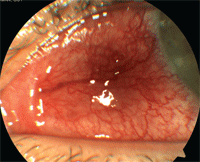 Q: I have a patient with severe sectoral injection of the nasal quadrant of the conjunctiva in the left eye. What is my differential diagnosis?
Q: I have a patient with severe sectoral injection of the nasal quadrant of the conjunctiva in the left eye. What is my differential diagnosis?
A: “The differentials are conjunctival abrasion, episcleritis, pingueculitis, pterygium, phlyctenulosis, or maybe something as simple as a subconjunctival hemorrhage in that quadrant,” says Priti Panchal, O.D., ocular disease resident at Omni Eye Services in Atlanta.
Her patient is a 57-year-old white male who presented with what appeared to be a subconjunctival hemorrhage in the left eye and complained of discomfort and a fairly severe, dull, boring ache. His visual acuity was 20/20 and he reported no photophobia. The referring doctor had tentatively diagnosed episcleritis, and prescribed Pred Forte (prednisolone acetate 1%, Allergan) five times a day. After 24 hours, the patient showed no improvement and was referred to Omni Eye Services for evaluation of the persistent pain and sector injection.
Severe injection of the conjunctiva along with persistent, boring pain suggest scleritis.
“When the patient came into our office, he explained that he woke up one day about a week earlier with a red eye,” Dr. Panchal says. “Since then, the redness and pain had only gotten worse, and surprisingly, the steroid drops didn’t make it any better. He was taking ibuprofen 600mg to 800mg, but that wasn’t helping much with the pain.”

Dr. Panchal estimated grade 4-plus chemosis in the affected eye overlying the severe injection; the conjunctiva was encroaching upon the cornea nasally. “From the history and the amount of pain, we tentatively diagnosed scleritis,” she says. An oral steroid, a Medrol Dosepak (methylprednisolone 4mg, Pfizer) was prescribed, and the topical steroid and antibiotic drops were continued.
Dr. Panchal and Omni’s anterior segment specialist Lawrence Woodard, M.D., saw the patient five days later and confirmed the diagnosis as scleritis. “The patient reported that the pain was 90% better. The eye was still red, but the chemosis was down 80% to 90% from what I had seen initially,” Dr. Panchal says. “It was good that his doctor of optometry caught it when he did, because it could have possibly turned into posterior scleritis, which is much harder to treat.” When the Medrol Dosepak was finished, the patient was placed on oral prednisolone 20mg b.i.d. and continued Pred Forte q.i.d.
Q: What is the treatment for scleritis? Should I comanage cases like this?
A: Treatment for scleritis typically involves an oral NSAID for pain along with a topical steroid and an oral steroid for inflammation. In this patient’s case, two weeks of such therapy still didn’t do the trick, so Dr. Woodard gave the patient a subconjunctival steroid injection, and continued the previous therapy.
“If it’s a severe, stubborn case—as this one proved to be—then I’d definitely recommend comanaging with an anterior segment specialist,” Dr. Panchal says. “But, if it’s a milder case and you can prescribe oral steroids, treat it on your own and observe carefully.”
After the steroid injection, the patient was looking and feeling much better, and continued to improve over two weeks until it was totally resolved.
What causes scleritis? Half the time it’s idiopathic, but the other half of the time it’s due to a systemic disease such as rheumatoid arthritis, ankylosing spondylitis, systemic lupus erythematosus, polyarteritis nodosa, Wegener’s granulomatosis, herpes zoster ophthalmicus, gout, syphilis or tuberculosis. So, once the inflammation has been alleviated, send the patient for blood work, Dr. Panchal says.

